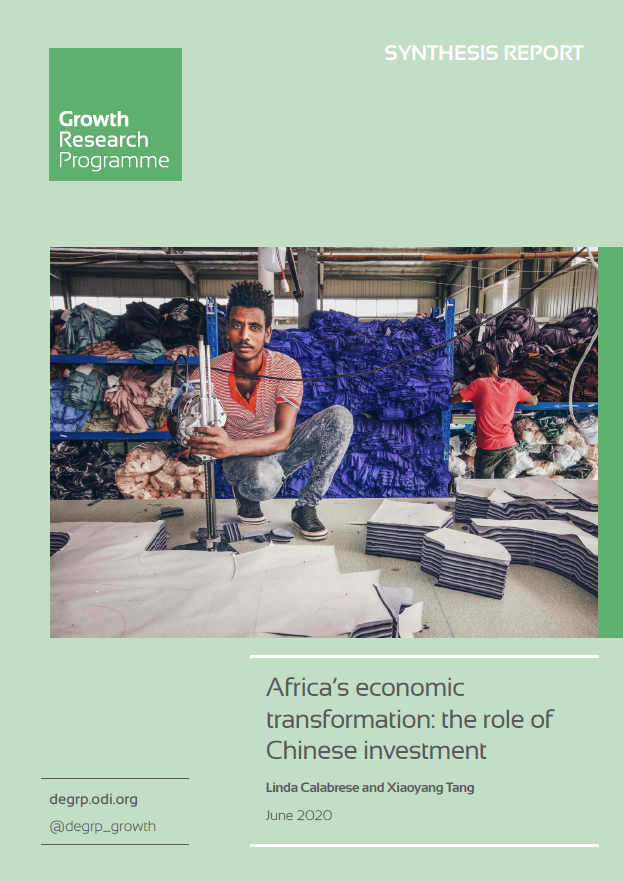Africa's economic transformation: the role of Chinese investment

Remarkable quotes from the extensive 37-page UK research report on Poverty Alleviation Research
Africa’s economic transformation: the role of Chinese investment
Linda Calabrese and Xiaoyang Tang – UK DEGRP, ESRC-DFID Joint Fund for Poverty Alleviation Research (*) (June 2020)
A robust conceptual and empirical basis for development with strong potential for impact on policy and practice for poverty reduction


Major implications for policy
- Policy-makers need to create mechanisms and policy tools to promote the creation of these linkages between African and Chinese firms, building their capacity to work with each other.
- Vertical knowledge transfer through building backward and forward linkages is more effective than horizontal transfer through demonstration and competition. Policy attention should be focused on linking foreign direct investment (FDI) projects with upstream and downstream local businesses instead of isolated projects.
- While joint ventures and other longer-term forms of collaboration between Chinese and African firms have strong potential, these are rare occurrences. Supporting such partnerships could be a useful way to strengthen knowledge transfer.
- Build managerial skills and encourage labour mobility. Chinese firms support skills development for low- and semi-skilled workers, but higher technical and managerial skills are still not present. The latter seem a priority, as they would not only support business, but also lead to spillovers. In the case of Bangladesh, the rapid growth of the ready-made garment sector was due to the spread of skilled workers and managers, highlighting the importance of labour mobility. Similarly in African countries, labour mobility could be encouraged.
- Chinese investment is seeking access to domestic markets rather than chasing low costs for exports. Targeted investment promotion should take this into account.
Mythes
The Chinese presence in Africa has fostered misconceptions and myths about the nature and impact of this engagement. Fuelled by the media and by political figures, these misconceptions include claims that Chinese companies generate few jobs, and mostly for Chinese nationals; that the working conditions in Chinese firms are exploitative, and characterised by low wages; and that Chinese companies make limited contributions to skills development for African workers. Other issues concern land grabs and, more generally, exploitation of Africa’s natural and human resources.
Evidence
- Chinese firms investing in Africa contribute to substantial job creation for African workers, with high localisation rates. Most of the jobs created are at the low- and semi-skilled levels.
- Chinese companies are found to build the skills of host countries’ workers. Chinese companies usually provide some form of training to local workers, but more complex technical and managerial tasks often remain with Chinese workers. Comparative research found no difference between Chinese and European firms in managerial knowledge transfer.
- For African firms, absorbing the technical and managerial skills of their Chinese counterparts remains a challenge. This is linked to the limited labour mobility of managers and skilled workers.
- Vertical knowledge transfer through building backward and forward linkages is more effective than horizontal transfer through demonstration and competition. Longer-term supply or subcontracting relationships would be highly beneficial in terms of increasing productivity of African firms, we see few examples of such relationships. More established partnerships, such as joint ventures between African and Chinese firms, are the exception rather than the rule.
- Wages paid by Chinese firms are not different from those paid by other firms. In some cases, Chinese firms are found to offer non-wage benefits to workers.
- Chinese investment tends to contribute to increased economic growth, in particular through investment in productive sectors (manufacturing). In some cases the Chinese engagement can contribute to the creation of new sectors in unexpected ways.
- African countries are not seen by Chinese investors as low-cost destinations to produce for third markets, but rather as viable markets in their own right. Therefore, the contribution of Chinese investment is not in boosting Africa’s exports, but in providing wider access to cheaper goods for African consumers.
- Chinese financing, by contributing to infrastructure building, it promotes the creation of further economic activity and generates spillovers: the construction of digital infrastructure in many African countries, and the construction of transport and energy infrastructure and industrial parks.
- Consumer goods imported from China have competed with, and negatively affected, African industries; but in some cases they have also spurred healthy competitions. Imports of machinery from China have also contributed to boosting economic activity in Africa.
China-Africa relations: evidence and myths
- While the US, UK and France are concentrated in financial services and extractives, Chinese companies invest in transport infrastructure, extractives and manufacturing.
- In manufacturing, studies have highlighted the destructive impact of Chinese imports on African manufacturing while others have pointed to the productivity-enhancing effects of Chinese investment through direct competition and higher quality of inputs.
- In African agriculture, while much attention has focused on fears of Chinese ‘land-grabbing’, Chinese engagement also has potential for aiding the diffusion of productivityenhancing technology.
- The Chinese government provides aid to African but these are limited compared to business cooperation: concessional loans account for approximately 20% of all the funding provided to Africa.
- Infrastructure projects are commonly financed through loans or aid; in some cases, Chinese own some equity in the project.
Chinese engagement in Africa: risks and opportunities for Africa
- African economists argue that China is a ‘golden opportunity’ for Africa, and that engagement with China can help Africa break away from aid and move towards a more business-oriented approach.
- China’s increased presence in Africa can also create a degree of healthy competition for African firms and for more established donors and investors on the continent.
Jobs and skills
- Employing people in high-productivity activities not only increases productivity in the economy, it also builds workers’ skills, attracting further investment and growth.
- African employees: make on average 85% of the total workforces in the Chinese firms studied.
- Chinese firms spent much effort in labour training. Most companies reported learning-by-doing or on-site training.
- Since most Africans employed by Chinese firms had no similar work experience before, large companies also gave formal inductions on topics like corporate rules, workplace safety and labour discipline to educate industrial culture.
- When it comes to knowledge transfer, Chinese enterprises face more challenges than European ones, given the presence of linguistic and cultural barriers.
Firm-level spillovers
- Relations between firms are an important source of learning that stimulates productivity gains. Firms can compete with one another, learning from their competitors; or they can learn from their partners, buyers and suppliers.
- The extent of knowledge spillovers from Chinese investments to African companies.
- through exchange and competition with companies in the same sector, through labour mobility, or the movement of workers from one firm to another;
- firms in sectors that require complex production skills and longer-training process, e.g. the furniture industry, have shifted more skills and responsibilities to local staff than those in assembly-line industries;
- most of the workers in construction sites and assembly lines were semi-skilled.
- Experienced local technicians were a scarce resource in Africa, and they were highly sought after by foreign competitors.
- Few host country firms succeeded in absorbing the knowledge because the capacity gaps between the Chinese and African companies were too large. Chinese firms were found to have much tacit knowledge in their management practice instead of explicit codified rules. This makes it difficult for entrepreneurs from a different cultural background to replicate.
- The learning effects for local companies through horizontal channels turned out to be modest and partial. Knowledge can also be transferred vertically along the value chain, namely through backward and forward linkages with local suppliers, subcontractors and clients.
- Long-term supply or subcontracting relationships with frequent interactions are found to be most beneficial for knowledge transfer, as they provide financial stability and clear targets for the local firms to upgrade.
- The effects of vertical knowledge transfer were more obvious and widespread than those of horizontal spillover channels like demonstration and competition. Companies exporting to advanced economies often use more imported supplies because of high-quality requirements, whereas those selling in local markets tend to source more supplies in the host countries to save costs.
- Chinese-African joint ventures were found to be relatively rare, on average amounting to less than 10% of the total Chinese investments, but the technical collaboration through joint ventures turned out to be more intense and effective than through other channels.
- Spin-offs set up by former local employees of Chinese companies constitute another possibility to transfer managerial and technological knowledge.
- Local technicians established their firms to work as subcontractors or suppliers for their previous Chinese employers. Such spin-offs were welcomed and sometimes supported with technical assistance by the Chinese firms because local firms have unique advantages to access markets and resources.
- Several Chinese companies adopted the model of contract farming to produce cotton, tobacco and rice, cooperating with hundreds of thousands of local small farmers.
Productivity and technology
- By engaging in the global production chain, local firms can better access advanced technologies, for example applying the imported machinery and equipment into local production, bringing technology embedded goods and services, getting technological assistance from foreign suppliers, as well as learning through disassembling the imported products.
Wages and livelihoods
- The wages paid by employers from China and from other countries was quite similar. Chinese firms offered additional benefits like dormitories and meals, which increased the African workers’ real incomes. Such measures are not seen in companies of other origins. Several hi-tech companies like Huawei and ZTE pay very competitive salaries to attract local talent.
- Chinese companies provide wages well beyond the poverty wage, but the relatively high living costs in urban areas posed challenges for African workers, especially migrants.
How macro-shifts in China influence economic transformation outside China
- Growing labour costs in a slowing-down economy is the main driver for Chinese enterprises to invest in other developing regions like Africa.
- Technologies and business models used by Chinese enterprises are more suitable for labour- abundant countries than resource- or capital-rich ones
- Chinese investments, unlike speculation-oriented capital from the high-income economies, primarily aim to promote productivity both domestically and in other low- and middle-income countries.
Sectoral transformations
- One of the most relevant aspects of Chinese engagement in Africa’s economic transformation is the impetus it can give to the creation or expansion of high-productivity sectors of the economy, thus contributing to structural transformation.
- They play an important role in helping host countries accumulate foreign reserves and facilitating technology transfer in these sectors. ‘Flying geese’ type relocations of labour-intensive industries (Ethiopia) constitute only a part of Chinese manufacturing investments in Africa. The majority of Chinese firms in manufacturing and construction sectors are not about relocation from China, but rather are new investment targeting the domestic market in African countries.
- The Construction industry boom in Africa has been gaining importance in the economic dynamics there, contributing to production capacity, generating business interests and inducing investment demand in backwardly linked building materials manufacturing, and thereby generating some opportunities for much-desired economic diversification in Africa.
- Chinese funding bodies were financing critical infrastructure that other funding bodies were reluctant to finance and follows the logic of ‘building ahead of time’. Chinese investment and financing for telecoms projects substantially accelerated the construction of Africa’s mobile networks and supported the fast-growing sectors of e-commerce, software and app development.
- The rural economy in Southern Africa experiences remarkable transformations. The arrival of Chinese and other Asian investors caused disruptive structural changes in the cotton sector, favouring low-cost models and crowding out traditional Western and local state-owned firms.
- Small- and medium-sized foreign investors, often of Chinese origin, participate increasingly in Tanzania’s artisanal and small-scale mining of gold and copper, bringing in much-needed capital, technologies and know-how.
Sector-level spillovers
- Chinese enterprises tend to invest in groups, either by sector or geographically. This unique pattern has generated impacts on sector-level development and industrial policies in Africa. The Eastern Industrial Zone, which was established in 2007 outside Addis Ababa, provided an eye-opening experience for policy-makers in Ethiopia to observe the role of industrial parks in attracting FDI and promoting early-stage industrialisation. Consequently, the Ethiopian government launched its own zone programme.
- Learning from China’s development experience, the Ethiopian industrial zones concentrate first-class facilities, streamlined administration and preferential policy to attract FDI’s. Labour-intensive manufacturing investments that can employ large numbers of local workers and earn foreign exchange through export, for example garment and footwear making, are particularly targeted.
- Chinese investors have also become lead manufacturers in the zones in Kenya, Tanzania, Rwanda, Ghana and Nigeria.
- Investment concentration facilitates interconnections and competition between the enterprises and forges the build-up of value chains in host countries, thus reducing transaction costs and raising productivity of the entire sector more quickly.
- The traditional industries in Ghana, such as food, furniture, garment, textile and wood, were found to benefit more from trade with China than the non-traditional industries, which suffer from scarce technology and production resources.
Building a workforce for a transformed economy
- The arrival of numerous Chinese investments considerably shapes the process of incorporating the host countries into dynamic global production networks.
- Chinese investments in the low-income countries primarily aim to promote productivity rather than seek capital gains, therefore, they are more eager and effective to expand the labour force in these countries to meet the demand of growing industrial production.
- The surveys in Angola and Ethiopia find that Chinese firms contributed the lion’s share of newly created jobs between 2013 and 2018 accounting for over 60% of new jobs in some years. As Chinese investments concentrated in high-productivity manufacturing and construction sectors, they were able to attract local labour from low-productivity subsistence activities.
- The globally integrated Chinese manufacturers in Ethiopia required the creation of a more dynamic and formalised industrial workforce than that required by the factories oriented to the Angolan domestic market. New labour–capital conflicts arose with expanding industrial capitalism. It is also a global pattern that the relocation of capitalist production systems is accompanied by the relocation of labour–capital tensions.
Politics and institutions
- Chinese capital does not seek short-term returns, and is more suited to longer-term development. This model relies heavily on policy banks whose additional objective is to create markets for Chinese goods and services. Chinese infrastructure deals are both economic and geopolitical, bringing together policy considerations while at the same time creating markets.
- In terms of their labour market outcomes, Chinese firms behave in ways that are largely similar to other foreign firms, refuting claims of ‘Chinese exceptionalism’.
COVID-19. The findings remain relevant to African governments as they think about how to recover from the economic shock caused by the pandemic and consider the role Chinese investment could play in that recovery.
(*) DEGRP, ESRC-DFID Joint Fund for Poverty Alleviation Research. A broad strategic partnership between the UK’s Department for International Development (DFID), UK’s Economic Social Research Council (ESRC)and UK’s Overseas Development Institure (ODI) the Joint Fund provides a robust conceptual and empirical basis for development with strong potential for impact on policy and practice for poverty reduction. (Ahead of the merging of the UK's DFID with the Foreign and Commonwealth Office)



Maak jouw eigen website met JouwWeb